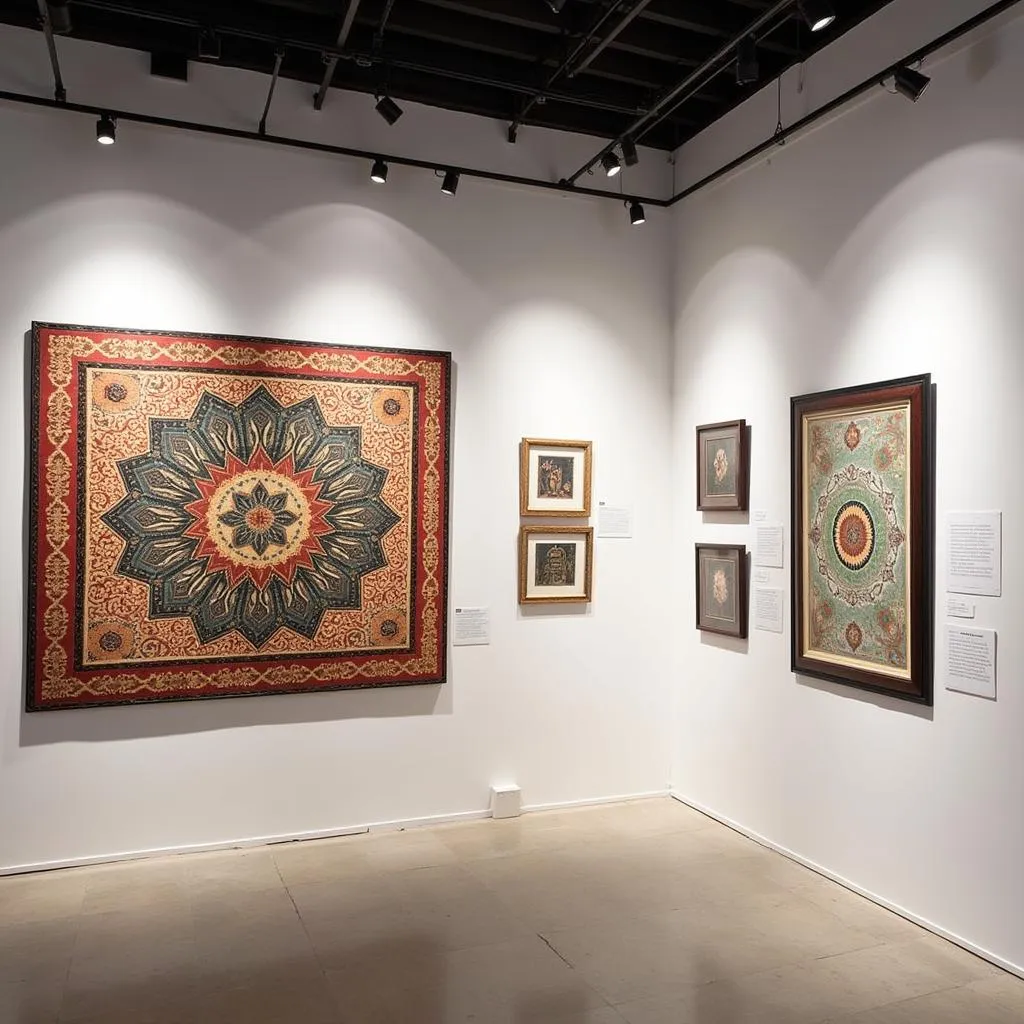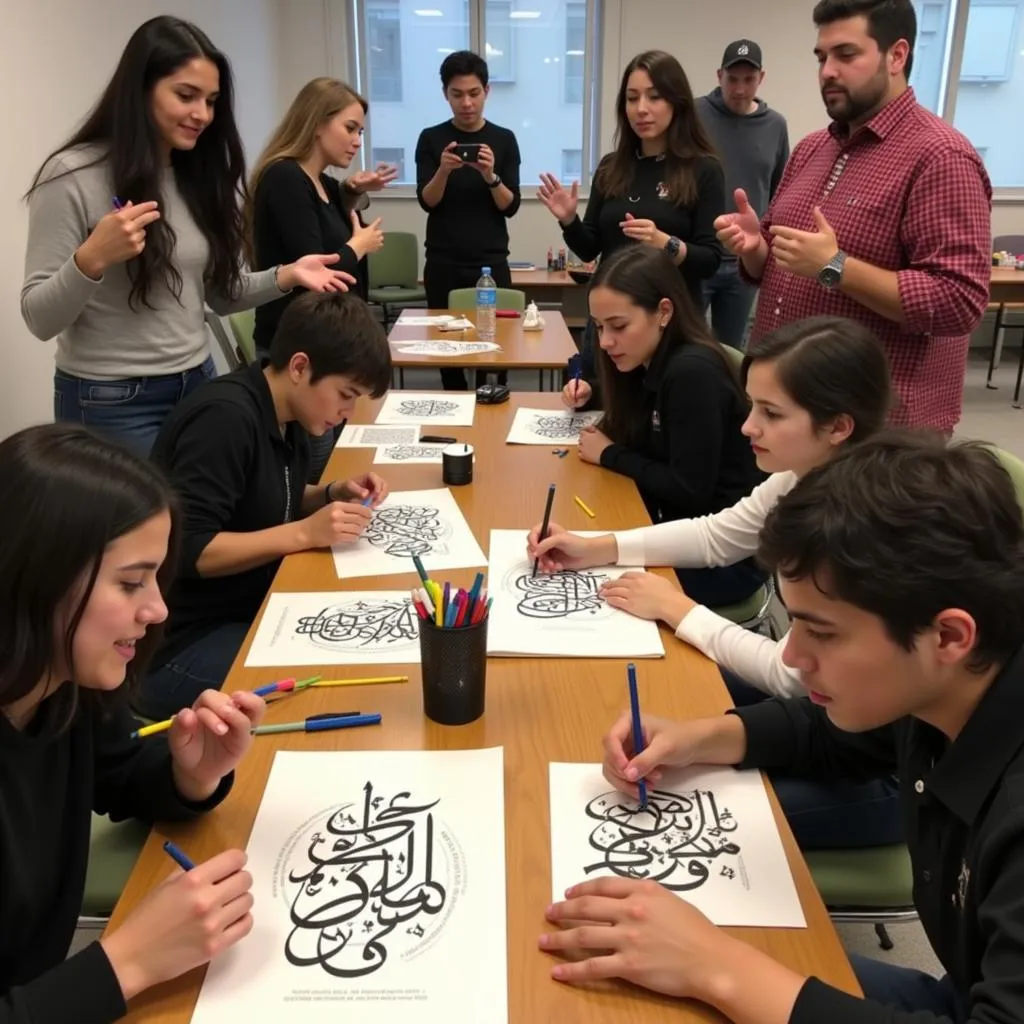The Islamic Arts Society is a vibrant organization dedicated to fostering appreciation and understanding of Islamic art and culture. Through exhibitions, lectures, workshops, and publications, the society provides a platform for individuals to engage with this rich artistic heritage and explore its enduring influence on the world.
A Journey Through Time and Space: The Scope of Islamic Art
Islamic art spans centuries and encompasses a vast geographic region, from Spain and Morocco in the West to India and Southeast Asia in the East. This diverse artistic tradition encompasses a wide range of mediums, including:
- Architecture: From the intricate mosques of Cordoba and Istanbul to the magnificent Taj Mahal, Islamic architecture is characterized by its stunning geometric patterns, soaring minarets, and intricate calligraphy.
- Calligraphy: As a sacred art form, calligraphy holds a central place in Islamic art. The graceful strokes of Arabic script adorn mosques, manuscripts, and everyday objects, reflecting the beauty of language and the power of faith.
- Textiles: The vibrant colors, intricate patterns, and luxurious materials of Islamic textiles have captivated art lovers for centuries. From carpets and tapestries to garments and embroideries, these textiles showcase the craftsmanship and artistic ingenuity of Islamic weavers and embroiderers.
- Ceramics: Islamic ceramics are renowned for their exquisite glazes, delicate patterns, and masterful craftsmanship. From the blue-and-white tiles of Iznik to the lusterware of Spain, these ceramic masterpieces reflect the artistic sophistication of Islamic civilizations.
- Metalwork: The intricate designs and elaborate ornamentation of Islamic metalwork demonstrate the mastery of metalworkers in this tradition. From jewelry and weapons to decorative objects and furniture, these works showcase the beauty and functionality of metal as an artistic medium.
The Islamic Arts Society: A Hub for Learning and Appreciation
The Islamic Arts Society serves as a crucial hub for individuals seeking to delve deeper into the world of Islamic art. Through its various programs and initiatives, the society aims to:
- Promote understanding: By showcasing diverse examples of Islamic art from across the world, the society seeks to challenge preconceived notions and foster a broader understanding of Islamic culture and its artistic contributions.
- Encourage dialogue: The society provides platforms for scholars, artists, and enthusiasts to engage in discussions about Islamic art, exploring its historical contexts, artistic techniques, and contemporary relevance.
- Foster appreciation: The society offers a variety of programs and resources, including exhibitions, lectures, and publications, to inspire and engage audiences of all ages and backgrounds.
The Impact of Islamic Arts: Beyond Aesthetics
The influence of Islamic art extends far beyond its aesthetic appeal. Its rich symbolism, intricate patterns, and elegant forms have played a significant role in shaping:
- Architecture and Design: The geometric patterns and intricate designs of Islamic art have inspired countless architects and designers throughout history. From the Moorish architecture of Spain to the Art Deco movement of the 20th century, Islamic art continues to influence contemporary design aesthetics.
- Fashion and Textiles: The vibrant colors, intricate patterns, and luxurious fabrics of Islamic textiles have inspired fashion designers for centuries. From the intricate embroidery of traditional garments to the bold prints of contemporary clothing, Islamic textiles continue to shape the world of fashion.
- Literature and Music: The elegant calligraphy and expressive poetry of Islamic art have influenced the development of literature and music. From the rich literary tradition of Arabic poetry to the soulful melodies of Sufi music, Islamic art has contributed significantly to the cultural landscape of the world.
The Islamic Arts Society: A Bridge to Understanding
The Islamic Arts Society serves as a bridge between cultures, offering a unique perspective on the world’s artistic heritage. By exploring the beauty and complexity of Islamic art, individuals can gain a deeper appreciation for the diversity and richness of human creativity.
“The study of Islamic art is essential not only for understanding the past but also for building a more tolerant and interconnected future.” – Dr. Sarah Khan, Art Historian and Curator
Frequently Asked Questions
1. What is the history of the Islamic Arts Society?
The Islamic Arts Society was founded in 1977 with the aim of promoting the study and appreciation of Islamic art. The organization has since grown into a global network of scholars, artists, and enthusiasts dedicated to celebrating and preserving this rich artistic heritage.
2. How can I get involved with the Islamic Arts Society?
There are many ways to engage with the Islamic Arts Society. You can become a member, attend exhibitions and lectures, participate in workshops, or donate to support the organization’s initiatives.
3. What are some of the key exhibitions organized by the Islamic Arts Society?
The Islamic Arts Society has organized numerous exhibitions showcasing the breadth and diversity of Islamic art. Some notable exhibitions include “The Arts of Islam” at the Metropolitan Museum of Art in New York and “The Treasures of Islamic Art” at the Louvre Museum in Paris.
4. What are some of the resources available on the Islamic Arts Society website?
The Islamic Arts Society website offers a wealth of resources for those interested in exploring Islamic art. You can find information about exhibitions, publications, lectures, and workshops, as well as articles and essays by leading scholars in the field.
5. What are some of the challenges facing Islamic art in the modern world?
Islamic art faces various challenges in the modern world, including the preservation of heritage sites, the protection of cultural artifacts, and the fight against Islamophobia. The Islamic Arts Society actively works to address these challenges through its advocacy efforts and educational programs.
 Islamic art exhibition showcasing diverse artifacts
Islamic art exhibition showcasing diverse artifacts
Conclusion
The Islamic Arts Society plays a vital role in fostering appreciation and understanding of Islamic art and culture. By connecting individuals to this rich artistic heritage, the society empowers them to engage in meaningful dialogue, challenge preconceived notions, and celebrate the enduring beauty and influence of Islamic art. Through its exhibitions, lectures, and publications, the Islamic Arts Society offers a unique opportunity to explore the world of Islamic art and discover its profound impact on the world.
 Participants engaging in a calligraphy workshop
Participants engaging in a calligraphy workshop
For more information about the Islamic Arts Society and its programs, please visit our website or contact us directly. We look forward to welcoming you to the world of Islamic art.